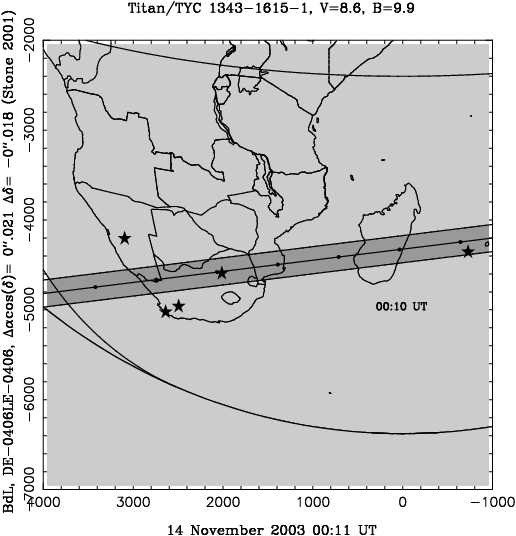

The star TYC 1343-1615-1 (B=9.9, V=8.6) will be occulted by Titan as seen from the Indian Ocean and Southern Africa.
Astrometry |
Note: the diagrams below are provided in chronological order, so the latest (and supposedly better) diagrams are at the end. Also, the radius of Titan's atmosphere is taken equal to 3100 km. Inside that radius, an observer should see a drop of stellar signal larger than a few percents. The "half-light radius" (the radius of the shadow where the stellar flux has been divided by two) is a little smaller, of the order of 3000 km.
From the Vizier link provided above for TYC 1343-1615-1, I get the
following ICRS/J200 position of the star on 14 November 2003 (proper
motion taken into account, annual parallax not taken into
account):
alpha= 06:55:20.9672
delta=+22:06:07.812
with typical errors of 10 mas.
The shadow of Titan's atmosphere (light grey band) and the central flash region (dark grey band) are shown in the figures below, with the center of the shadow plotted every minute.
The shadow moves from the right to the left.
Left panel: according to the IMCCE online ephemeris (DE-0406LE-0406) +
TASS theory for the saturnian satellites
Right panel: according to the JPL Horizon online ephemeris (DE-0406LE-0406 +
SAT136). Note that the two predictions are very close to each other,
and essentially differ in time.


 |
 |
 |
If one uses JPL ephemeris DE410 for Saturn (Myles Standish) and the SAT136 ephemeris for Titan (Bob Jacobson), then one gets the following predictions:
 |
 |
The two predictions above differ by about one minute in time, and by about 150 km (0.025 arcsec) perpendicular to the shadow track in the plane of the sky, i.e. half of the full width of the central flash. This should be considered as the typical error made so far in the predictions.
ASTROMETRIC UPDATE !!! Images showing simultaneously Titan and TYC 1343-1615-1 have been taken on October 6/7, 2003, by François Colas, using the 1.2-m telescope at Haute Provence Obervatory.
An analysis of about 95 of these images by Agnès Fienga provides the predictions below.
 |
 |
This is very close to the prediction just above, i.e. the one using DE410 + SAT136. Note, however, that the errors in all these analyses still remain of the order of the full width of the central flash. Thus, even if these predictions agree with each other, some care must be taken when considering them: a shift of 500 km in the north-south direction, or/and an advance or delay of 1 minute are still possible!
Here is a zoom on the south-western coast of Africa, using the prediction above (the dotted line is the chord probed by the site at La Réunion):
 |
Codes are as follows: Ha= Hakos Observatory, Ti= Tivoli, So= Sossusvlei, Ma= Mariental, As= Asab, Ke= Keetmanshoop, Or= Orange River Lodge, Vi= Vioolsdrif, Sp= Springbok, Ka= Kamieskroon, Bi= Bitterfontein, Va= Vanrhynsdorp, Ce= Cederberg (spelling Sederberge ????), Cp= Cape Town, SAAO= South African Astronomical Observatory, PA= Prince Albert, Bo= Boyden Observatory, Jo= Johannesburg, Re= La Reunion.
The illumination of the Earth will be as follows:

Photometry |
Below is a table of measurements made by Jean Lecacheux with the 1-m telescope at Pic du Midi. The fluxes are in arbitrary units, the depth is = star/(star + Titan) and the S/N is defined as = star/2*sqrt(star+Titan). The S/N is thus a measure of how significant the drop of stellar signal is wrt the photon noise. The values of S/N in the last column are rather arbitrary, but their comparison may be useful when choosing a filter.
One can see that the CH4 filter, although is gives a better contrast, yields the poorest S/N due to the lack of photons in that filter.
The wide 530-900 nm filter seems to be the best compromise. This depends, however, on the detector and should be modulated according to the spectral response of each detector. Tests are advised!
Filter |
Flux Titan |
Flux star |
Depth |
S/N |
R |
11330 |
10768 |
0.49 |
36.2 |
530-900 nm |
23393 |
23621 |
0.50 |
54.5 |
V |
4723 |
4502 |
0.49 |
23.4 |
> 700 nm |
9794 |
12423 |
0.56 |
41.7 |
I |
4048 |
5653 |
0.58 |
28.7 |
893/5 (CH4) |
27.9 |
101.6 |
0.78 |
4.5 |